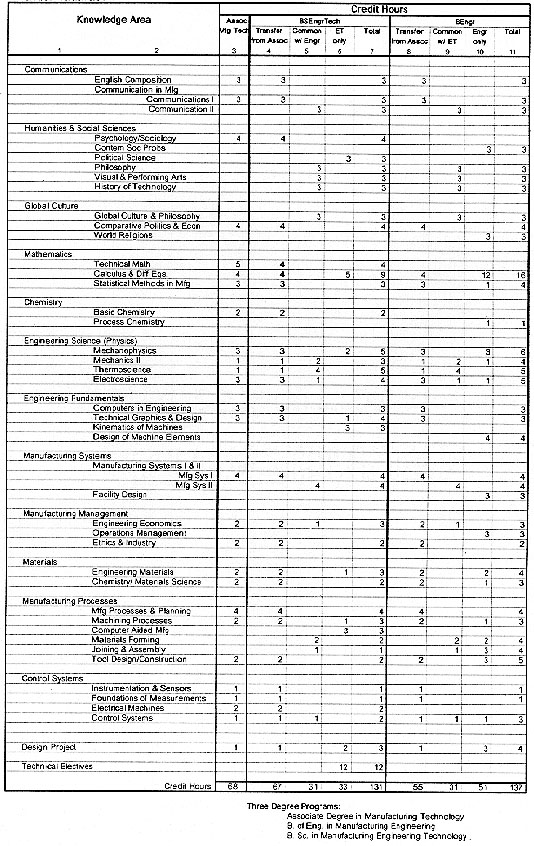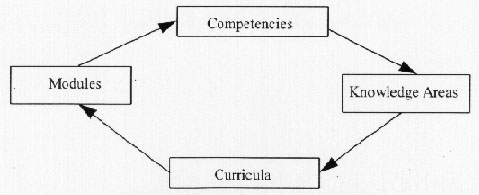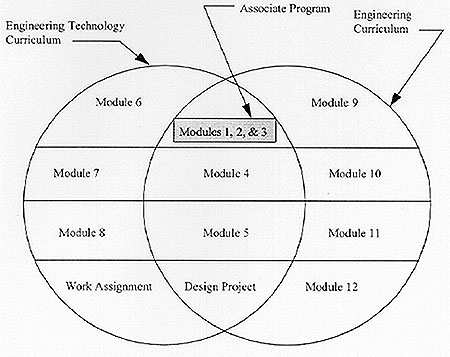
Coalitions are usually formed for the purpose of effecting change, and change often results in stress, stress for both the people and the system involved. The Greenfield Coalition is about change, changing the design and delivery of manufacturing engineering and engineering technology education, as well as the way universities administer academic programs. Needless to say the coalition has experienced stress and made its share of mistakes in its efforts. The following provides some insight to some of the more important lessons that the coalition has learned along the way: issues that need to be considered when forming a coalition, importance of equality of partnerships, operation of coalition committees, mixing of different cultures, and maintaining interest of partners. Hopefully others will benefit from the lessons that the Greenfield Coalition has learned and not make the same mistakes.
The Coalition
The Greenfield Coalition was established in 1994 with an NSF Engineering Education Coalition grant. The mission of the coalition has been and is to establish a new paradigm in manufacturing engineering education that integrates actual manufacturing experiences into the academic program and links three new undergraduate degree programs. The coalition has designed and is implementing the three degree programs, an associate in manufacturing technology, a baccalaureate in manufacturing engineering technology, and a baccalaureate in manufacturing engineering, for a population of non-traditional students. These programs are being delivered to the candidates (students) at the workplace, the Focus:HOPE Center for Advanced Technology.
The Curricula
The unique features of the Greenfield curricula (Table 1) are the integration of engineering and engineering technology programs built upon a common associate program. The curricula are competency based having been formulated from a set of competencies that the university and industry partners defined during the first year of the coalition. The development cycle that the coalition has followed and is engaged in is illustrated in Figure 1.
Table 1. Greenfield Curricula

As indicated in Table 1, the curricula are defined by knowledge areas which are threaded across the three programs. In order to facilitate the unique integration of the three degree programs, the individual knowledge areas are, in general, subdivided into one credit courses. Defining the knowledge areas as a sequence of one credit courses also provides our candidates with more opportunities for celebration of success and reduces the impact of not mastering a topic since only a segment of a total knowledge area need be repeated. In addition, the individual courses within a knowledge area are subdivided into modules. This facilitates the delivery of the learning materials for the curricula by means of computer-based instruction (CBI). The various knowledge areas are linked at the module level by means of prerequisite requirements. This too is being done to facilitate the integration of the three programs. Figure 2 offers a picture of how the three programs are linked within a given knowledge area. The coalition is working to change the role of the faculty from that of lecturer to one of coach.
Experiential Learning
Figure 2 also illustrates one means of integration of actual work experiences with the academic programs. One of the coalition projects is the mapping of all work assignments within the Center for Advanced Technologies that the candidates might have during their work/educational program. An activity matrix is being designed that maps the department or general category of work, e.g. production, engineering, sales, purchasing, etc., against the level of responsibility or job difficulty. Each assignment is being detailed as to duties or learning objectives, process competencies required, education/training learning objectives, learning assets, and process inquires. With this information available the coalition will then begin trying to identify when it is more appropriate to shift the learning from the classroom to the workplace, giving actual credit for work related tasks. In addition to this the faculty are being asked to use case studies and examples from the CAT as a vehicle for presentation of course materials, and to assign projects that are related to the workplace.
Virtual University
One of the more difficult objectives of the coalition is trying to establish a virtual university out of the partnership of the coalition partners. This is easier said than done. Universities are very protective of their own policies/procedures and maintaining control. Just the thought of change sends tremors through the institution. Most institutions have a limit on the number of transfer credits that are acceptable. As the coalition works to build a virtual university for delivery and awarding of the degrees, those institutions managing the Greenfield degree programs are being asked to accept any and all courses taken, as part of the Greenfield curricula, from partner institutions as 'home" courses. Thus, the limit on transfer credits would have to be modified. In addition, the three institutions awarding the Greenfield degrees are being asked to include the transfer of grades as well as credits from partner institutions, and include these grades in the computation of any and all grade points averages.

Figure 1. Development of Curricula up

Figure 2. Relationship of Modules in a Knowledge Area to Degree Programs up
These and other issues are currently under consideration. While the final disposition is unsure at this time, the coalition is searching for the ways and means to succeed in this endeavor.
Establishing A Coalition
At the very beginning of the process of forming a coalition, the politics and positioning gets underway. Each constituent is looking to see what the other partners will get and comparing that to their allocations. Hence, it is critical that each partner feels comfortable with the partnership, sees the developing relationships as a positive one, and believes that there will be equable treatment.
Coalitions are usually established to bring about change. Hence, it is important that the mission of the envisioned coalition be understood by all potential participants from the beginning. There must be no surprises about the mission of the coalition later. From the outset, the corporate/institution partners and individuals must be chosen with care. Moreover, it is important to invite specific individuals to join the leadership of the coalition and contribute to the overall planning and formation of the partnership. Partners should be selected on the basis of the contributions that each can make and for no other reason. There must be a philosophical alignment within the partnership along with a sincere and firm commitment to stay the course in carrying the mission of the partnership. Each partner should be bringing a uniqueness to the coalition and willingness to stand as an equal partner with the others.
Without question, there must be a willingness to work on the part of all participants. It is only through the commitment and dedication of the partners that the coalition has a chance of realizing success. Giving the partners the opportunity to choose the roles they wish to play within the coalition will ensure maximum effectiveness.
Finally, the partners must be willing to set aside self interest and put the interest of the coalition before their own. This is not easy when participants are competitors in the outside world or very protective of the way they conduct their own business. As might be expected this is more likely to be a fault of university partners than industry partners within an educational coalition
Equality Among Partners
A coalition must be built upon trust, and trust comes from being secure in the belief that all partners (will) receive near equal treatment, that favoritism will not be given to one or more of partners. Just the perceptions of favoritism or partiality toward one or more partners can cause conflict and disruption. Hence. the leadership of a coalition must constantly be examining what is being done and thinking about how decisions and actions will be interpreted by the partners.
We all know that money, or the allocation of monies to coalition partners, can be the root cause of many problems. When the Greenfield Coalition was first established the decisions regarding responsibility for specific projects and the allocation of project development funds were made collectively and to the satisfaction of all partners. When it came time to make decisions about assignments of new projects and the allocation of project development funds, a decision was made that faculty would compete for the projects. Faculty members from coalition institutions were to submit competing proposals and a panel, composed of other coalition faculty, was to select what was perceived to be the "best" for funding. This immediately pitted partner institutions against one another. We had colleagues passing judgement on colleagues. The seeds for mistrust were planted. Cracks began to form within the coalition. And, unfortunately, the process did not necessarily ensure that the best proposals were accepted.
The coalition realized the mistake that had been made and took steps to correct a bad situation. In subsequent years the coalition went back to making decisions collectively, ensuring that every partner had an opportunity to make known their interest in a project and to participate in projects of their interest. Moreover, the final decisions are being made collectively so that no one has cause to feel slighted. In following this process, it becomes the obligation for all of the partners to take responsibility for quality of work.
Once mistrust develops within a coalition, it is not easy to remove it. It is critical that each and every partner has the opportunity to participate not only in the decision making but after the decisions are made, too. Once a decision is made it becomes the responsibility of the leadership of the coalition to facilitate wide spread participation of all partners and to see that the coalition stays on course.
The role of the leadership of a coalition is one of achieving conclusions through consensus. When this can be done all partners will be taking ownership in the work of the coalition. It should be no surprise that when a vote has to be taken to achieve a decision, those who were voted do~n will have little investment in the decision.
Coalition Committees
The Greenfield Coalition is comprised of six universities, six corporations, Focus:HOPE (a civil rights organization), and the Society of Manufacturing Engineers. This is a diverse group of partners. It has been a strong partnership over the past three years, but not without some stress and strain at times. Fortunately, because of the commitment of the partners, the coalition has been able to cope.
Because a coalition is a partnership of a number of individual institutions, it will generally function through a committee structure. To have an effective committee structure it is critical that committee responsibilities be clearly defined and made known to all and that there be clear lines of communication between committees and across the organization. Also, there must be a recognized point of decision making. But the one key ingredient to having an effective committee structure is empowerment of the committees to do their work and make appropriate decisions.
Committees only work when all of the partner representatives participate and contribute. When an organization is operating through a committee structure, the organization is dependent on the good will and interest of the committee members. These people are being asked to give of their time and talents. If they do not perceive that their efforts are being appreciated by others then they will soon drop out. Hence, it is critical that the committees be empowered to carry out their mission. This point can not be emphasized enough: committees must be empowered to carry out their missions. It is a formula for failure when a committee is asked to work but consistently has its work and decisions overturned by others, be it an individual or another committee, outside of the committee. Even a coalition can fall victim to micro management.
With a committee type organization, it can be effective to utilize small working groups to develop ideas and recommendations. This provides some economy of time and effort required of the partners. In addition, it can speed up the decision making process. However, a word of caution. Be sure that all of the partners have an opportunity to participate in the decision making process at some stage of that process.
Mixing of Two Cultures
We frequently forget that there are significant differences between the cultures of academic institutions and the corporate business world. And if these differences are not recognized and respected by the partners coming from these two different worlds, the coalition will pay a expensive price, and that may even be failure.
We all know that academics like to talk and, if given the opportunity, they will talk a subject to death. It is just in our nature. However, on the other hand, people coming from industry are more interested in getting to the core of the issue and coming to resolution. For them, talk is time. time is money, and that adds to the cost of doing business. Unfortunately, when the culture of the academics prevail, the industry partners will soon disappear from the scene. It is critical that the two groups develop an appreciation for each other, but more importantly, it is essential that the academics come to understand the need to limit discussion and focus on development of a decision. As director of the Greenfield Coalition I must constantly remind myself of the need to keep discussions on target and not let them go on longer than is productive.
But this issue is more than just limiting time spent on discussions, talking. It is also about listening. Too often academics dismiss what the folks from industry have to say. This is a big mistake. We academics can learn a great deal from our industry partners.
When we are asking people to give of their time it becomes important not to misuse that time. When an organization is dependent on committees to carry out its mission, there must be a vigilance not to waste the participants' time and energy. Otherwise the very individuals that a coalition depends on will find good reasons to be absent.
Maintaining Interest
In the beginning of any new endeavor, interest and enthusiasm will run high, and people are generally willing to volunteer to participate. After three years the excitement has diminished and people find other things calling on their time and efforts. Maintaining a high level of participation over several years can be a challenge. There will be some turnover in people involved with the coalition and that can be planned for. But it is essential for the overall health of the coalition that partners not become tired and just wander away.
The leadership of the coalition must be constantly measuring the level of involvement and interest in the work of the coalition on the part of the partners and working to keep interest and involvement high. At the time a coalition is established commitments are made to a mission, a purpose. Hence, if the coalition is to be successful, it should never be passive about lack of involvement on the part of a partner. The leadership must maintain open lines of communications with the partners and have a sense of the expectations that each of the partners have of the coalition. Work with the partnerships to address the concerns and issues that they raise.
Over the life of a coalition it will be necessary to find new tools, terminology, and techniques to maintain and assist in communication and problem solving. There must be a continuing search for ways and means of keeping the excitement of the work of the coalition alive. Part of the problem comes when people do not feel that their work is appreciated by others. At times we forget that people need to have some recognition for their efforts and that a good "thank you" can go a long way to making people feel that their efforts are appreciated.
Summary
Looking back on the day the Greenfield Coalition came into being, it was certainly easier to write about how the coalition would operate and what it would do than actually bring the words to reality. In the beginning there was some naivete on the part of many of the institutional partners, and few of the major participants had any experience in building a coalition partnership. But over the years some hard lessons have been learned.
There are several key ingredients that must be present to have a successful coalition. The first is trust. If trust between the partners, and this includes respect, is established early and is never violated. the coalition can achieve most any goal it sets for itself. The second is commitment. There must be a deep, unwavering commitment to the mission of the coalition, and a willingness to put the coalition needs before the individual needs of the individual partners. The third is a willingness to change. With trust, commitment, and a willingness to change success will come with hard work.
The Greenfield Coalition is, after three years of work, just beginning to realize its dream.